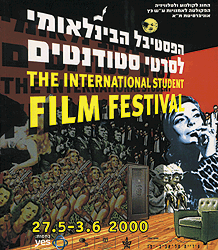Janet Ginsburg reveals the subtle timing of when an agent is needed and when an agent might hinder getting that job.

A curious phenomenon in Israel is that of an outburst of creativity in the wake of each war. Most noticeably evident in increased numbers of pregnancies and arts events. A few of these events have developed into a tradition of international celebrations. The major ones concerning film take place in the three major cities, situated in a triangle 45 to 90 minutes drive from each other. The international festival in Haifa, up north on the Carmel Mountain, started in 1983. The Jerusalem festival started in 1984. Both are annual and include one or two compilations of animation shorts. Occasionally a couple of animation features are also screened. The annual Creative Filmmaking festival in Tel Aviv is dedicated mainly to animation and started in 1994. Currently it is on hold however, awaiting budget allocation. These festivals do not feature animation in competition. The only competitive festival awarding animation is the student film festival. The following may give an idea of what this unique festival is like:
8th International Student Film Festival, Tel Aviv
The year is 1986. Two graduating students at Tel Aviv University keep bothering everyone with the idea of an international student film festival, to be run by students and focusing on students. Using all of their savings to travel to schools around the world, they managed to get enough blessings, films, support and visiting students, lecturers and professionals to make the first festival a success. Since then, every two years, the Tel Aviv University film department becomes the festival's headquarters. Its graduates direct and produce the event, while students from all the schools in Tel Aviv host the visiting foreign students. A lively crowd joins the students in a week long celebration of films, workshops, lectures and parties, yielding friendships and working relationships which will last for years.
This year's festival (May 27 June 3, 2000) included in its competition some 50 screening hours composed of 164 films, selected by 61 schools from 40 countries. Twenty-two of the films competed in an "Animation and Experimental" category*, which will be separated next festival. The festival represents schools' attitudes rather than a worldview of student creativity. Festival regulations limit participation to members of the international CILECT association, which is an association of film schools. Each school is allowed up to 50 minutes of screening time. These rules, however, have a decisive influence on the animation selection as very few art schools join CILECT. Therefore, most film schools prefer sending two impressive 25 minute documentary or fiction films, rather than short animated films.

An international nine member jury, composed of directors, students and lecturers -- none of which involved in animation -- selected three films as prize nominees:
- Matthew Hood's Hourglass. Made at the NFTS, in Beaconsfield, U.K., this 5 minute film tells the life cycle of a "sand woman" confined in glass, who is running out of time while having a sandy offspring. The film is an impressive display of computer 3D and 2D animation combined with drawings.
- Gil Kenan's Shoot the Moon. From UCLA in the USA, this 5 minute monologue is of a child telling the disastrous history of his community, a kingdom forced to build a giant gun in order to shoot the moon. The film is black and white, limited animation created with cut-outs.
- Aurel Klimt's The Magic Bell from Praha's FAMU in the Czech Republic is a 15 minute fun musical with intentionally sloppy cut-out animation. The film tells the rather wild story of a village made happy by a special bell. When an evil army steals the bell and molds it into a canon, a rescue mission by a little girl and a lost circus elephant succeeds in bringing a happy end. The film was awarded the prize for best animated film.
* Animated films selected by schools for the competition:Like Drowning, Cath Murphy, 8 minutes. VCA, Melbourne, Australia.Extra Terrestrial, Ivan Russev, 3 minutes. NATFIZ, Sofia, Bulgaria.Man on the Moon, Chris Stenner, 7 minutes. FABW, Ludwigsburg, Germany.Silent Saviour, Ekuba Kyiamah, 5 minutes. NAFTI, Akra, Ghana.It's Your Turn, Alessia Milo, 6 minutes. SNC, Roma, Italy.The Telephone, Ekaterina Visnapou, 6 minutes. VGIK, Moscow, Russia.Spirit of Flight, Soh Wee Lian, 3 minutes. Ngee Ann Polytechnic, Singapore.Hourglass, Matthew Hood, 5 minutes. NFTS, Beaconsfield, UK. Last Waltz In N.Y., Avi Katz, 6 minutes. SVA, N.Y., USA.Shoot the Moon, Gil Kenan, 5 minutes. UCLA, L.A., USA.3 films from FAMU, Praha, Czech Republic: F.I.S.H. 073, Vaclav Svankmajer, 7 minutes; The Magic Bell, Aurel Klimt, 15 minutes; Mumps, Maria Prochazkova, 7 minutes.2 films from Camera Obscura, Tel Aviv: Scenario, Omer Makover, 7 minutes; These Things Never Happened But Are Always, Linor Fonseca, 7 minutes.2 from VSMU, Bratislava, Slovak Rep.: In the Box, Vladislav Stuhar, 6 minutes; Doble Voice Invention A-Minor, Vlado Kral, 2 minutes.Plus, 5 films from Bezalel Academy of Art & Design participated in a separate competition for Israeli student films.
Tsvika Oren is a veteran animator, film critic, lecturer and animation missionary. He is also Director of The Animation Center in Tel Aviv and the International Creative Filmmaking festival.







